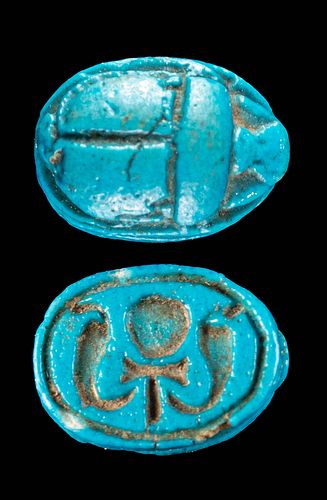Superb Egyptian Faience Scarab Pendant w/ Ankh & Uraei
Lot 8a
About Seller
Artemis Gallery
686 S Taylor Ave, Ste 106
Louisville, CO 80027
United States
Selling antiquities, ancient and ethnographic art online since 1993, Artemis Gallery specializes in Classical Antiquities (Egyptian, Greek, Roman, Near Eastern), Asian, Pre-Columbian, African / Tribal / Oceanographic art. Our extensive inventory includes pottery, stone, metal, wood, glass and textil...Read more
Categories
Estimate:
$800 - $1,200
Absentee vs Live bid
Two ways to bid:
- Leave a max absentee bid and the platform will bid on your behalf up to your maximum bid during the live auction.
- Bid live during the auction and your bids will be submitted real-time to the auctioneer.
Bid Increments
| Price | Bid Increment |
|---|---|
| $0 | $25 |
| $300 | $50 |
| $1,000 | $100 |
| $2,000 | $250 |
| $5,000 | $500 |
| $10,000 | $1,000 |
| $20,000 | $2,500 |
| $50,000 | $5,000 |
| $100,000 | $10,000 |
| $200,000 | $20,000 |
About Auction
By Artemis Gallery
Oct 21, 2021
Set Reminder
2021-10-21 10:00:00
2021-10-21 10:00:00
America/New_York
Bidsquare
Bidsquare : Fall Antiquities & Ethnographic Art Auction
https://www.bidsquare.com/auctions/artemis-gallery/fall-antiquities-ethnographic-art-auction-7725
Ancient art from Egypt, Greece, Italy and the Near East, as well as Asian, Fossils, Pre-Columbian, Native American, African / Tribal / Oceanic, Fine art, and much more! All categories, all price ranges... all legally acquired and guaranteed to be as described or your money back. Artemis Gallery info@artemisgallery.com
Ancient art from Egypt, Greece, Italy and the Near East, as well as Asian, Fossils, Pre-Columbian, Native American, African / Tribal / Oceanic, Fine art, and much more! All categories, all price ranges... all legally acquired and guaranteed to be as described or your money back. Artemis Gallery info@artemisgallery.com
- Lot Description
Ancient Egypt, New Kingdom, 18th to 20th Dynasty, ca. 1550 to 1077 BCE. A mold-formed faience scarab pendant from the New Kingdom period, covered in lustrous layers of brilliant blue glaze. The top of the ovoid pendant exhibits insectile features including a folded wing carapace, slender legs, and a petite head with a fan-shaped clypeus; a suspension hole is oriented lengthwise through the body. Centered along the bottom is a recessed image of an ankh - an ancient symbol for life or eternal life - flanked by a pair of royal uraeus cobras (plural uraei). Size: 0.625" L x 0.4" W (1.6 cm x 1 cm)
Provenance: private Toronto, Ontario, Canada collection, by descent, acquired in Egypt in 1894 to 1896
All items legal to buy/sell under U.S. Statute covering cultural patrimony Code 2600, CHAPTER 14, and are guaranteed to be as described or your money back.
A Certificate of Authenticity will accompany all winning bids.
PLEASE NOTE: Due to recent increases of shipments being seized by Australian & German customs (even for items with pre-UNESCO provenance), we will no longer ship most antiquities and ancient Chinese art to Australia & Germany. For categories of items that are acceptable to ship to Australia or Germany, please contact us directly or work with your local customs brokerage firm.
Display stands not described as included/custom in the item description are for photography purposes only and will not be included with the item upon shipping.
#167130Minor nicks and abrasions to topside and bottom, with light encrustations, otherwise intact and very good. Wonderful preservation to hieroglyphs on bottom as well as blue glaze pigment throughout.Condition
- Shipping Info
-
All shipping is handled in-house for your convenience. Your invoice from Artemis Gallery will include shipping calculation instructions. If in doubt, please inquire BEFORE bidding for estimated shipping costs for individual items.
-
- Buyer's Premium



 EUR
EUR CAD
CAD AUD
AUD GBP
GBP MXN
MXN HKD
HKD CNY
CNY MYR
MYR SEK
SEK SGD
SGD CHF
CHF THB
THB














